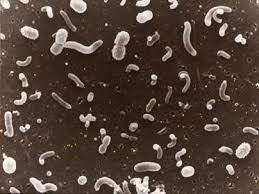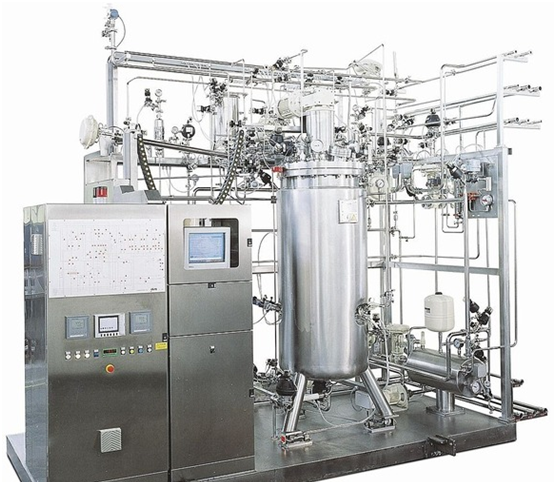Lactic acid bacteria (LAB) are a group of Gram positive, non-sporing bacteria that carryout lactic acid fermentation of carbohydrates or sugars. Lactic acid fermentation is a type of fermentation carried out by LAB in which sugars including glucose, lactose and pentoses are converted to lactic acids or a mixture of lactic acids and other products. There are two types of lactic acid fermentation. Homolactic fermentation is the type of lactic acid fermentation in which sugars such as lactose are entirely converted to lactic acid.
Homofermentation is defined as any fermentation in which only one end-product is produced. The terms homofermentation and homolactic fermentation are synonymously used. In homolactic fermentation, only one product (i.e. lactic acid) is produced at the end of the fermentation process. The lactic acid bacteria that carryout homolactic fermentation are generally known as homofermenters.
Homofermenters produce mainly lactic acid through the glycolytic (Embden–Meyerhof) pathway. Lactococcus lactis, Streptococcus species and thermobacteria are examples of bacteria that carryout homolactic fermentation. These bacteria metabolize lactose or glucose by the glycolytic pathway to produce pyruvate molecules that are converted solely to lactic acid. Heterolactic fermentationis the second type of lactic acid fermentation carried out by LAB.
Heterolactic fermentation is a type of lactic acid fermentation in which sugars such as lactose or glucose are fermented or converted to a range of end-products. Heterofermentation is any fermentation in which there is more than one end-product produced. The terms heterofermentation and heterolactic fermentation are synonymously used. In heterolactic fermentation, sugars are converted to a mixture of lactic acid and other products such as CO2, acetic acid or ethanol.
Heterolactic fermentation is usually carried out by two metabolic pathways including the 6-phosphogluconate/phosphoketolase pathway and the glycolytic pathway. Lactic acid bacteria that carryout heterolactic fermentation is generally known as heterofermenters; and they produce lactic acid plus appreciable amounts of ethanol, acetate and carbon dioxide through the 6-phosphogluconate pathway. C are examples of heterofermenters.
LABs are cocci or rod shaped bacteria which produce lactic acid as the major end product of the fermentation of carbohydrates. They are used extensively in the food industry; and LABs are the most important bacteria in desirable food fermentations because of their unique characteristics. LABs are responsible for the fermentation processes of dough/bread, beer, all fermented milks, alcoholic/non-alcoholic beverages, cassava and most pickled (fermented) vegetables. They are important group of bacteria in diary industries. LABs are nutritionally fastidious and weakly proteolytic bacteria.
Thus, they require additional growth nutrients such as amino acids and vitamins for growth, and they weakly break down or metabolize proteins. The main genera of LABs involved in these fermentation processes include Lactobacillus, Leuconostoc, Pediococcus, Bifidobacteria and Streptococcus. Lactic acid bacteria carry out their reactions (i.e. the conversion of carbohydrate to lactic acid plus carbon dioxide and other organic acids in some cases) without the need for oxygen. They are described as microaerophilic organisms – since they can function in the presence of minimal oxygen or the absence of it.
Microaerophiles or microaerophilic organisms are bacteria that can function in the presence of small amounts of oxygen. Because of this, the changes that they effect do not cause drastic changes in the composition of the food. Though LABs can also cause food spoilage in some conditions, the lactic acid they produce is effective in inhibiting the growth of other non-desirable bacteria that may decompose or spoil the food. LABs are a group of bacteria with a diverse group of organisms with a diverse metabolic capacity – that is responsible for their varied metabolic activities.
This diversity makes them very adaptable to a range of conditions and is largely responsible for their success in acid food fermentations. Most starter cultures used in food/diary industry to initiate fermentation are composed of lactic acid starters. Lactic acid starter cultures are used to initiate lactic acid fermentation in the commercial production of a variety of products including but not limited to yoghurt, vinegar, and other baked and diary food products. LABs are Generally Regarded As Safe (GRAS) microbes that can be used for the production of foods meant for human and animal consumption without causing any adverse health consequences.
References
Bader F.G (1992). Evolution in fermentation facility design from antibiotics to recombinant proteins in Harnessing Biotechnology for the 21st century (eds. Ladisch, M.R. and Bose, A.) American Chemical Society, Washington DC. Pp. 228–231.
Nduka Okafor (2007). Modern industrial microbiology and biotechnology. First edition. Science Publishers, New Hampshire, USA.
Das H.K (2008). Textbook of Biotechnology. Third edition. Wiley-India ltd., New Delhi, India.
Latha C.D.S and Rao D.B (2007). Microbial Biotechnology. First edition. Discovery Publishing House (DPH), Darya Ganj, New Delhi, India.
Nester E.W, Anderson D.G, Roberts C.E and Nester M.T (2009). Microbiology: A Human Perspective. Sixth edition. McGraw-Hill Companies, Inc, New York, USA.
Steele D.B and Stowers M.D (1991). Techniques for the Selection of Industrially Important Microorganisms. Annual Review of Microbiology, 45:89-106.
Pelczar M.J Jr, Chan E.C.S, Krieg N.R (1993). Microbiology: Concepts and Applications. McGraw-Hill, USA.
Prescott L.M., Harley J.P and Klein D.A (2005). Microbiology. 6th ed. McGraw Hill Publishers, USA.
Steele D.B and Stowers M.D (1991). Techniques for the Selection of Industrially Important Microorganisms. Annual Review of Microbiology, 45:89-106.
Summers W.C (2000). History of microbiology. In Encyclopedia of microbiology, vol. 2, J. Lederberg, editor, 677–97. San Diego: Academic Press.
Talaro, Kathleen P (2005). Foundations in Microbiology. 5th edition. McGraw-Hill Companies Inc., New York, USA.
Thakur I.S (2010). Industrial Biotechnology: Problems and Remedies. First edition. I.K. International Pvt. Ltd. New Delhi, India.
Discover more from #1 Microbiology Resource Hub
Subscribe to get the latest posts to your email.



